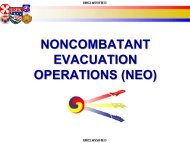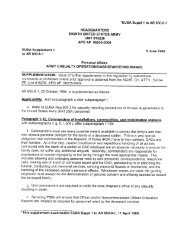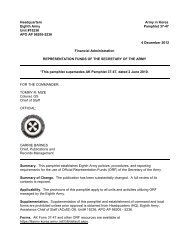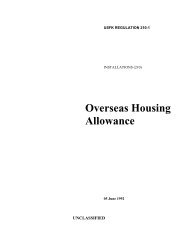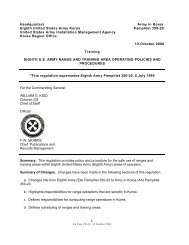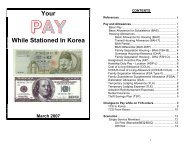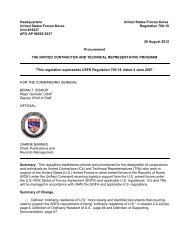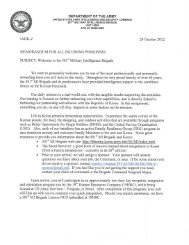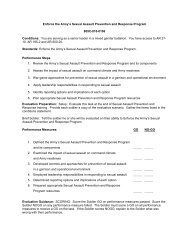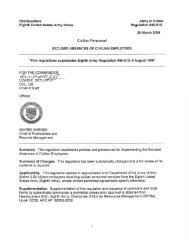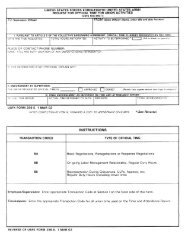AK Pam 750-6 Chemical Agent Resistant Coating.pdf - Eighth Army ...
AK Pam 750-6 Chemical Agent Resistant Coating.pdf - Eighth Army ...
AK Pam 750-6 Chemical Agent Resistant Coating.pdf - Eighth Army ...
Create successful ePaper yourself
Turn your PDF publications into a flip-book with our unique Google optimized e-Paper software.
(2) Aviation ground support equipment painted with CARC will have the word ‘CARC’<br />
stenciled near the data plate in black, using one-inch letters.<br />
(3) Aircraft requiring a complete CARC repainting as determined by supporting Aviation<br />
Maintenance Company (AMC) will be reported through the Brigade Aviation Maintenance Office<br />
(BAMO) to 19th ESC SPO (EANC-DGM-MAC, 768-8238/ 8237).<br />
2-4. Health/Environmental Hazards and Safety Requirements<br />
a. Vapor<br />
(1) Spray painting results in significant aerosolization of paint and solvents. Painting<br />
materials may also contain lead, zinc chromate, chromium VI and hexamethylene diisocynate<br />
(HDI). Exposure to solvent is expected in confined spaces during the brush or roller painting,<br />
drying or curing process. Welding and cutting operations on CARC coated metal can release<br />
significant quantities of isocyanate.<br />
(2) Every effort must be made to ensure proper ventilation of paint area to rid the area of<br />
toxic vapors as quickly as possible. All personnel must be made aware of dangerous toxic vapors<br />
generated by CARC paint and trained on the use of proper respirator and other PPE. An effective<br />
respiratory protection program and use of PPE must be incorporated into SOP to safeguard the life<br />
and health.<br />
b. Fire<br />
(1) The mist generated from spray gun is highly flammable. Open cans containing paint<br />
removers, thinners, paints, primers, and oil or solvent-soaked cloths are a fire hazard.<br />
(2) Accurate mixing of two component coatings, according to instructions provided with<br />
each kit, is crucial since sufficient amounts of material cause chemical polymerization to occur.<br />
Mixing must be conducted in a well ventilated mixing room or spraying area away from any open<br />
flames, welding torches, and combustion heaters. All mixing containers must be dry and clean,<br />
and personnel doing the mixing must wear eye protection and other PPE to ensure a full<br />
protection.<br />
c. Contact with Paint Material<br />
(1) Skin contact with paints, primers, removers and thinner can convey toxic materiel to<br />
food or water during the whole paint process.<br />
(2) Avoid skin contact with paint material. Personal protective equipment will be worn to<br />
prevent skin contact.<br />
d. Dust and Noise<br />
(1) Grinding and sanding painted surfaces can expose personnel to hazardous dust with<br />
high concentrations of lead, zinc, copper, tin, chromium VI, and noise and eye injury hazard.<br />
(2) Approved respirators, eye, and hearing protection must be used during grinding and<br />
sanding operation, and the area must have a noise and eye protection hazards signs posted.<br />
5<br />
<strong>AK</strong> PAM <strong>750</strong>-6, 26 April 2013



